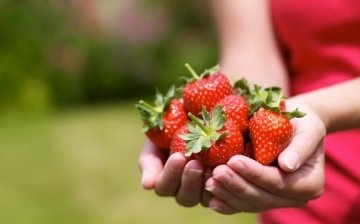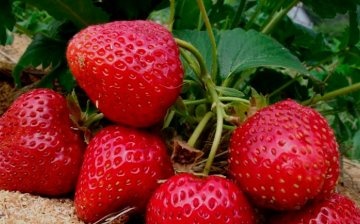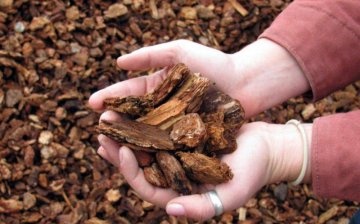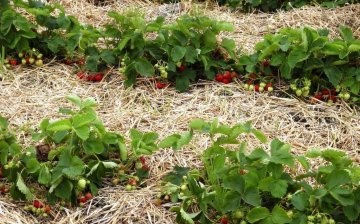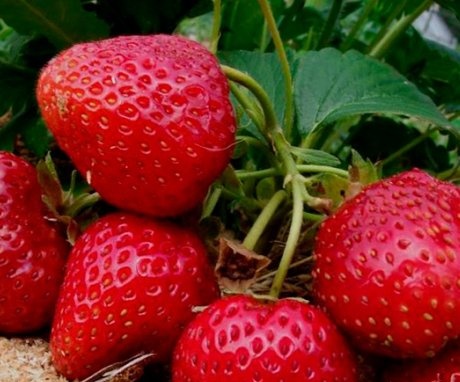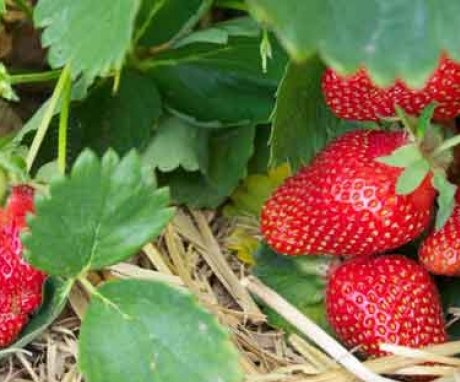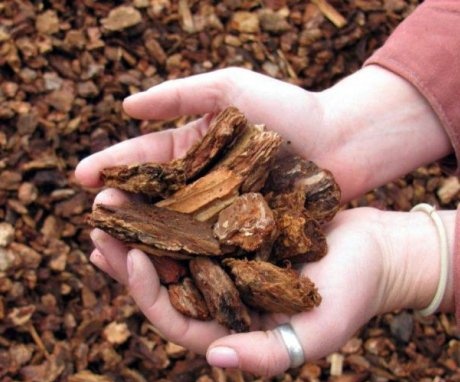Mulching strawberries: types of mulch and rules of use
Mulching - a process that occurs naturally in nature and which man began to use when growing plants. It has long been noticed that the soil responds gratefully to the covering with a protective layer. Mulching the soil in strawberry beds can significantly increase yields and reduce labor costs for plant maintenance.
Content:
Materials for mulching strawberries: types and description
Mulching is covering the soil with a layer of any material for the purpose of protection and enrichment. Mulching strawberries can be done in two types of materials:.
- Inorganic materials - polyethylene film, roofing felt, spunbond - are durable, but the qualitative composition of the soil does not improve when they are used.
- Organic mulch (hay, straw, sawdust, pine needles, etc.), on the contrary, enriches the soil well with organic matter, but it needs to be changed annually or even twice a year.
Plastic wrap is a relatively inexpensive material, but it is unlikely to last more than two seasons. In addition, a light film requires reinforced fastening, the soil under the film is often waterlogged. Dampness, in turn, causes root decay and the development of fungal diseases... But under the film, the soil warms up faster and retains heat well. The sun's rays do not penetrate through the dark film, and thus growth is inhibited weeds... Although, according to gardeners, weeds germinate under the black film. In specialized stores, you can find pre-cut and two-color films. A two-color film has a light outer side and a dark inner (bottom) side. The light side protects against overheating of the soil, and the dark inner side, which does not transmit light, prevents weeds from developing. The light layer has the property of reflecting the sun's rays, thereby protecting the leaves strawberry from burns.
Spunbond (non-woven fabric) is more durable: it can be used for several years in a row, it passes water well when watering, preventing it from evaporating at the same time.
Spunbond can be successfully replaced with roofing material: it is an absolutely safe (non-toxic) material for plants. Lutrasil (also made of non-woven material), developed by German scientists, is successfully used as mulch. Available in light and black colors. Light lutrasil is used for greenhousesand black as mulch when grown strawberry... It perfectly protects plants from frost: one layer of lutrasil allows strawberries to withstand frosts down to -2 degrees, and a double layer - even up to -7 degrees.
Of course, organic mulch has a beneficial effect on the quality characteristics of the soil: when decomposing, it saturates the soil with nutrients, makes it lighter and more breathable. But, if there is no way to get organic materials, you can spend money on film or spunbond.
Spunbond (film) mulching:
- Make grooves up to 10 cm deep along the perimeter of the strawberry bed.
- The spunbond strip should be 25 cm longer and wider than the bed.
- In spunbond, make cross-shaped cuts for strawberries at a distance of 30 cm under future plants and at least 50 cm between rows.
- Put the material on the bed, lower the edges into the furrows, sprinkle them with earth.
- Make holes through the slots, plant strawberries and water.
When using the film as a mulching material, the time for the fight against unnecessary mustaches is significantly reduced: they simply have nowhere to gain a foothold.
Mulching with straw or hay:
- Shake the mulching material well to get rid of the weed seeds.
- Soak in water.
- Dry in the sun.
- Mulch is laid around the strawberry bushes in an even layer of 15 cm (later the material will settle).
Hay or straw is considered the best mulch option for strawberry... Even a small layer of this mulch will serve as a good weed control. After glaze the surface of straw mulch dries quickly enough, which protects strawberries from gray mold disease. Hay and straw enrich the soil with nutrients and improve its fertile layer.
The hay bacillus breeding in straw produces about eighty antibiotics and phytoncides, which practically reduces the likelihood of root rotting to zero.
Mulching with sawdust and shavings:
- Let the sawdust (shavings) rest for several months (fresh use is not recommended).
- Spread on the soil in a layer of 3 cm.
- It is not recommended to use sawdust (shavings) of poplar and oak, as well as from chipboard. Particleboard contains substances harmful to humans.
- According to gardeners, sawdust or straw mulch takes nitrogen from the soil, so add nitrogen-containing fertilizers to the soil: nitroammofoska solutions, chicken droppings or mullein.
- If the soil on the site is acidic, liming of the soil can be carried out before mulching.
- Some gardeners spread newspapers under sawdust, but we strongly discourage this. Printing ink is very toxic, and you can get a dose of harmful substances along with the tasty berry.
- When the sawdust darkens, it can be moved to compost heap... They maintain a high temperature of the compost, due to which its maturation is significantly accelerated. Sawdust with compost will serve as an excellent fertilizer for any type of soil. Replace the removed sawdust with new ones.
Needle mulching:
- The needles increase the acidity level of the soil, so you need to sprinkle a little lime under it on the soil. Alternatively, mix the soil with wood ash.
- Spread the needles in a layer of 3-5 cm.
- The main advantage of mulching with needles is protection from slugs.
Mulching with cardboard:
- Place cardboard (or thick wrapping paper, but not newspapers!) Overlap on the garden bed: one sheet covers the other by 20 cm.
- Spread a ten centimeter layer of soil on top.
- Leave for a week.
- After a week, make holes (piercing a layer of soil along with cardboard), plant strawberry bushes and water immediately.
- There is no need to water between plants.
- During the season, one watering is enough, in extreme heat - two.
- After strengthening the seedlings, do additional mulching with straw or cut grass.
- From time to time, you need to lift the cardboard and remove the slugs and snails, which are very fond of such materials.
Mulching with tree bark:
- Pre-grind the bark.
- Mix with topsoil.
- Put the cut grass on top.
- Bark mulching improves the quality of heavy soils.
As a mulching material, you can use forest litter - a fertile layer of forest soil. It will have the same effect on the soil as hay or straw. An additional advantage is the absence of pathogens diseases horticultural crops. The only drawback of such mulch is the laboriousness of its preparation.The cut grass as mulch should be used carefully enough: when rotting, it heats up very much, prevents the flow of air and moisture to the roots and will not be a good protection against weeds.
Mulching rules
The mulching procedure can be carried out in spring and autumn:
- In the spring - as soon as the fruit ovaries appear. The purpose of spring mulching is to prevent berries from contacting the ground. After harvesting or at the end of summer, the mulch is harvested.
- In autumn - at the end of October. Mulch will protect strawberry bushes from freezing, and in spring, after the end of frost, the old mulching material is removed. Materials such as straw, pine needles, fallen leaves and hay can be used to protect against the cold winter weather.
Dark mulching materials protect strawberries well from freezing and temperature fluctuations, and in spring they contribute to faster soil warming. This means that the harvest can be obtained a few days earlier.
The main rule when mulching is to cover only the soil around the strawberry bushes with material, avoiding the mulch getting on the plants.
Before mulching, you need to loosen the soil well, remove all weeds and add fertilizers... Experienced gardeners advise adding both organic and inorganic fertilizers to the soil. The soil in the beds is leveled and watered well.
It is important to remember that mulch retains moisture well, so the number of waterings is reduced by at least a third. To water strawberries recommended in the morning, so that the surface of the mulch dries up before nightfall. This will save the berries from diseases of gray mold. When using organic materials as mulch, it must be borne in mind that they decompose at a high rate and can become a source of fungi and bacteria. Therefore, remove the old mulch in a timely manner and add a new one.
Benefits of mulching
In the wild, no one spuds, loosens or fertilizes the soil, and plants develop better than with careful leaving... How does it work? The fact is that in nature it is almost impossible to meet naked land, with the exception of deserts, but nothing grows there.
Michurin also noted that on soil covered with any materials, plants develop two times better than on open soil.
Benefits of mulching:
- Improving soil quality by using organic materials as mulch.
- Protection of soil from the sun, weathering and erosion.
- Reducing the number of waterings.
- Moisture is distributed evenly, while at the roots the moisture level is 3-5% higher.
- Wet soil attracts earthworms, which naturally loosen the soil.
- There are no fluctuations in soil moisture and temperature.
- Aeration of the roots is doubled.
- No crust is formed on the soil.
- Different types of mulch can either raise or lower the temperature of the soil.
- Significant reduction in the number weeds.
- Increase in yield by 40-50%.
- Protection of berries from contamination.
- Defence from diseases and pests.
The disadvantages of mulching are that the soil under cover can become waterlogged and attract slugs and bear... Excessive soil moisture is a prerequisite for the development of fungal diseases. Therefore, it is important to choose a mulching material that is suitable for specific conditions, and be sure to monitor the condition of the soil.
More information can be found in the video.



